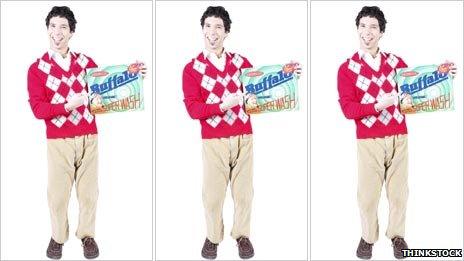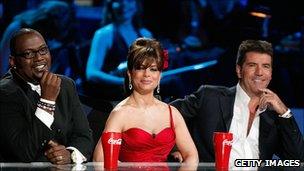Will product placement change TV?
- Published
- comments

Product placement has a long history in the US
At the cinema we're used to seeing James Bond zip around in his Aston Martin and the Sex and the City women sip branded vodka, but how will television change when advertisers can pay for the same sort of product placement?
TV enthusiasts will soon notice a stark logo displayed for three seconds at the beginning and end of television shows which have been paid to include products. The new logo has been mandated by communications watchdog Ofcom and will appear from 28 February.
For the 55 years of commercial television in the UK, viewers have been used to seeing advertising mostly only during the commercial break. But on US television there is a long history of product placement.
With varying degrees of subtlety, characters use products which companies are trying to sell. The reason is straightforward.
It's natural to watch your favourite character having a tipple and then want a glass of bourbon, or to watch a fast-paced thriller and feel compelled to run out and buy the latest bit of consumer electronics gadgetry.
And that's precisely the goal of product placement.
A mobile phone manufacturer might pay for a character in Hollyoaks to use its latest model or a chocolate firm might pay to have their confectionery featured in Coronation Street.

Product placements are common on US television shows such as American Idol
The US-UK disparity is clear on American Idol. In its original broadcast in the US the judges on American Idol are frequently seen with Coca-Cola cups in front of them. On British television, the cups are pixelated. But how would the advent of this sort of activity change programmes in the UK?
"It will change the appearance to an extent because it will allow products to be promoted in programmes in a way they haven't before," says media commentator Steve Hewlett. "It's new, but TV won't change overnight."
Product placement in films and international programmes has been allowed on UK television for many years, though commercial goods are often pixelated.
At present, brand names can only be placed in domestic programmes if no money has changed hands.
These products are considered props and are used on terms of a trade. A programme-maker decreases production cost by receiving a free prop and, in return, the company supplying the prop gets free publicity.
Now UK viewers will see placed commercial products in dramas, sitcoms, soaps and other programmes, but not on any BBC output, nor on any children's, news or religious affairs programmes.
But the average person won't detect most product placement, says Hewlett.
"I'd be surprised if most people noticed. If they start noticing then something is going wrong."
The eagle-eyed viewer, raised on American imports, might spot the prevalence of a particular brand of laptop, but placement is never going to be a character on Emmerdale looking into the camera and complimenting a particular brand of coffee.
Paid placement won't work unless the product can seamlessly blend with the editorial content, says creative branding expert Jonathan Gabay, of Brand Forensics.
"You have to be careful about which brand goes in which programme because it has to be appropriate. It's important to put the brand into context and to give it meaning."
Even the television critics suggest producers and writers will subtly feature brands by finding a delicate balance.
"I don't think it's going to muck up the programmes or have an artistic effect at all," says Guardian TV critic Julia Raeside. "It'll be much more subtle than that."
And the rules are strict.
Children's, news, current affairs, consumer affairs and religious programmes will not air any paid product placements. Ofcom regulations, external also prohibit gambling services; food and drink high in salt, fat and sugar; tobacco; medicines; alcohol; baby milk; weapons; and escort services.
So Coronation Street's fictitious Newton and Ridley ale won't be turning into Heineken any time soon.
There is going to be a big uptake on technical products such as laptops and mobile phones, but it's far more likely that most of the paid product placements will be fast moving consumer goods, like toothpaste.

James Bond films are known for their extensive product tie-ins
Because these products need to be purchased month after month and consumers tend to have less brand loyalty, the benefit to advertisers is greater, says Mr Gabay.
Most people won't consciously notice whether the cereal is in a nondescript plastic tub or a Kelloggs box, so they are more likely to buy the placement brand the next time they are at the supermarket, he adds.
It's this subliminal hold on viewers that has the citizen and consumer interest group the Voice of the Listener and Viewer (VLV) strongly opposed to paid product placements appearing on UK television.
The group says product placements can reduce the integrity of TV, because they are covert advertisements.
Regulations and signage is not enough, and the VLV would prefer product placements be eliminated entirely, a spokeswoman for the group explains.
"When you have sporting personalities and stars eating certain foods and using special products then the company is prepared to pay for it because it works," she says. "It has an impact particularly on vulnerable people and they don't realise they are being manipulated."
"It's [paid product placement] very common in America and in films, but that is no reason for us to reduce the integrity in the UK."
The concern that producers and writers will skew their content in the interest of advertising revenue is understandable, says Hewlett.
"Editorial content and commercial messages need to be completely and transparently separate. Product placement blurs that line because it puts a commercial product right into the middle of the programme."
"The concern is probably overstated because if the programmes get worse the viewers will vote with their remote controls. It would be entirely self defeating."
Instead, the bored viewer can play spot the placement if they choose.